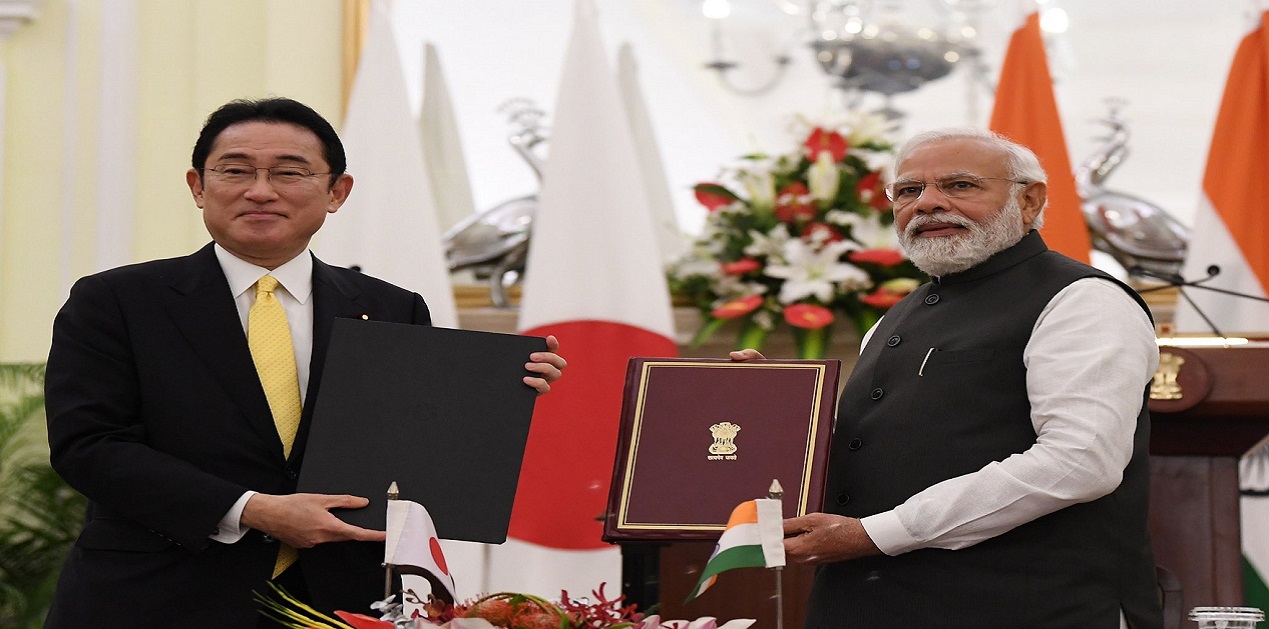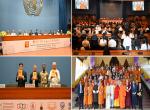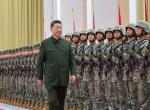In normal times, the 70th Anniversary of bilateral ties between India and Japan would have been celebrated with much fanfare; yet the occasion was marked with the 14th Annual Summit in New Delhi after the previous one had been held in Tokyo in Oct 2018. The visit by Prime Minister Abe in Dec 2019 had been postponed due to unforeseen domestic situation in both countries. With the ensuing pandemic, diplomatic summits were shifted online or held on the bylines of other major meetings in 2020 and 2021. Prime Minister Kishida’s visit to India, the first by a serving Japanese Prime Minister in nearly four and a half years, saw a reaffirmation of the close bilateral ties especially a new investment target from Japan for 5 trillion yen ($42 billion) in the next five years to India. This is significant when viewed through the 2019 launch of the India-Japan Industrial Competitiveness Partnership (IJICP) that would work toward enhancing India’s industrial competitiveness through discussion in areas such as development and utilization of industrial zones to promote foreign direct investment, lowering cost of logistics, and facilitating smooth governmental procedures.[1]
Both India and Japan are seeking to reinvigorate their domestic economies after a pandemic induced slowdown. While PM Kishida has spoken of a ‘new form of capitalism’ that balances growth and distribution and is driven by investments in digitization, green technology and human capital; PM Modi has articulated a vision of Aatmanirbhar Bharat or a self-reliant India that can balance its interdependence to the global economy by way of contributing more output. In this regard, both countries have launched major economic initiatives including large subsidies for onshoring of production. During COP 26 last year, both Japan and India committed to carbon neutrality by 2050 and 2070 respectively. In that spirit, the summit saw the upgradation of the India-Japan Energy Dialogue (established in 2007) into the India-Japan Clean Energy Partnership. The existing 5 Working Groups (WGs) of the energy dialogue were merged into 4 WGs: Electricity and Energy Conservation, New and Renewable Energy, Petroleum & Natural Gas and Coal.[2] PM Kishida also commended India’s initiatives such as the International Solar Alliance (ISA) and the Coalition for Disaster Resilient Infrastructure (CDRI) and conveyed that Japan would be joining the Indian-Swedish climate initiative LeadIT to promote heavy industry transition[3].
In recent years, the India-Japan economic partnership has risen steadily with Japan being the fifth largest investor in India with FDI stock of $36 billion and 1455 Japanese companies operating in India. In the last five years, India-Japan cooperation has expanded to include diverse sectors from automobiles, food processing, to urban planning and larger digital technologies. In December 2015, cooperation on developing India’s first high speed rail based on Japan’s Shikansen was signed when Prime Minister Abe visited India. According to NASSCOM-NRI report ‘Japanese Investments into India’s Technology Sector’, there are over 100 active Japanese investors who have funded over 240 Indian start-ups across 360 deals between 2000 and May 2021.[4] India on its part has reciprocated with visa on arrival for all Japanese travelers including for business purposes. Japan has also been one of the few active foreign investors in India’s Northeast region. The Act East Forum set up in 2017 has been pivotal in advancing cooperation in agriculture, connectivity, healthcare, skills training, etc. The summit saw a consolidation with the launch of the India-Japan Sustainable Development Initiative for the North-Eastern Region of India including the Initiative for Strengthening Bamboo Value Chain in the Northeast. There was also the renewal of the $75 billion currency swap agreement where both countries can swap their local currencies in exchange for US Dollars.
The enlarging security cooperation between India and Japan remains one of the brightest spots in the bilateral relationship. The first 2+2 ministerial meeting was held in Nov 2019 in New Delhi; a second meeting is expected to be convened this year in Tokyo. In defence technologies cooperation, India’s Defence Research and Development Organisation (DRDO) and Japan’s ATLA signed the Project Arrangement Concerning the Cooperative Research on the Visual SLAM Based GNSS Augmentation Technology for UGV/Robotics in July 2018. A major military logistics agreement, Agreement Concerning Reciprocal Provision of Supplies and Services between the Self-Defense Forces of Japan and the Indian Armed Forces (called "Acquisition and Cross-Servicing Agreement", or ACSA) was signed in September 2020. In March 2021, Japan issued its first official development assistance to India's Andaman and Nicobar Islands for the installation of a battery storage system. The two countries also have increasing range of military exercises in both bilateral and multilateral formats from Dharma Guardian to Malabar. Indo-Japanese security relations also took another step by agreeing in May 2018 to bolster cooperation in the field of cyber security and exchange IT professionals and a MoU to enhance cooperation in ICT, including 5G tech in Jan 2021.
On regional security architecture, both India and Japan share similar perceptions with growing cooperation in minilateral and multilateral formats in the Indo-Pacific. The two countries are comfortable voicing support on each other’s security concerns be it North Korea’s destabilizing ballistic missile launches or terrorist networks operating from Pakistan. Japan has also been very supportive of India’s candidacy for the Nuclear Suppliers Group and UN Security Council permanent membership. In recent time, the Quadrilateral Security Dialogue between the US, India, Japan, and Australia has grown from a nascent discourse into regular foreign ministers’ meetings and summit level dialogues. The Quad has not only focussed on reinforcing a rules-based order in the region but has also branched into providing common goods such as vaccines and infrastructure while bolstering intra-cooperation in new technologies and restructuring supply chains. The focus on China was unmissable in the joint statement as both India and Japan have faced incessant, unprovoked Chinese aggression on their land and maritime boundaries. The joint statement this time also highlighted economic coercion as a new challenge and mentioned need for diversified, resilient, transparent, open, secure, and predictable global supply chains that provide economic security. India and Japan also voiced similar regional positions be it on ASEAN centrality, Myanmar to implement ASEAN’s five-point consensus and addressing humanitarian concerns and an inclusive political system in Afghanistan.
But Ukraine conflict’s shadow on this summit remains probably one of the only points of difference. The Japanese media had highlighted how Kishida would ask India to take a clearer position on the conflict. In the joint press conference with PM Modi, PM Kishida noted that “the Russian invasion of Ukraine is a grave incident shaking the very essence of the international order[5]. We must respond in a firm and resolute manner. However, PM Modi in his remarks only stated that “geopolitical events are posing new challenges”. The joint statement later, mentioned “the serious concern about the ongoing conflict and humanitarian crisis in Ukraine and assessed its broader implications, particularly to the Indo-Pacific region”. Japan unlike India has gone along with the larger western position of crippling economic sanctions on Russia but backtracking on the strategic energy investments made in Russia’s Far East remain a challenge. Also, the earlier efforts by PM Abe to pursue a peace treaty with Russia and resolution of the Kuril Islands’ dispute, has come to a naught. For India, the realities of its defence cooperation with Russia as well as progressing on the post pandemic economic recovery have led to a different position. Yet, one can say the ramifications of Ukraine conflict will not hinder or obstruct the strengthening momentum of India-Japan ties.
References
[1]Press Release: Launch of “India-Japan Industrial Competitiveness Partnership”, https://www.meti.go.jp/press/2019/12/20191210003/20191210003-3.pdf
[2] India-Japan Clean Energy Partnership, https://www.mea.gov.in/bilateral-documents.htm?dtl/34992/IndiaJapan+Clean+Energy+Partnership
[3] India-Japan Summit Joint Statement Partnership for a Peaceful, Stable and Prosperous Post-COVID World, https://www.mea.gov.in/bilateral-documents.htm?dtl/34991/IndiaJapan+Summit+Joint+Statement+Partnership+for+a+Peaceful+Stable+and+Prosperous+PostCOVID+World
[4] Japan invested USD 9.2 billion in Indian start-ups till May: Consul General, https://www.newindianexpress.com/business/2021/nov/13/japan-invested-usd-92-billion-in-indian-start-ups-till-mayconsul-general-2383044.html
[5] Japan pushes India to denounce Russia, https://www.rt.com/news/552318-japan-india-russia-ukraine/
(The paper is the author’s individual scholastic articulation. The author certifies that the article/paper is original in content, unpublished and it has not been submitted for publication/web upload elsewhere, and that the facts and figures quoted are duly referenced, as needed, and are believed to be correct). (The paper does not necessarily represent the organisational stance... More >>
Image Source: https://twitter.com/narendramodi/status/1505226458301886467/photo/1











Post new comment